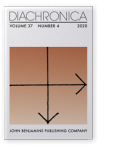Vol. 37:4 (2020) ► pp.540–576
Palenquero origins
A tale of more than two languages
Palenquero is a Spanish-lexified creole spoken in Columbia. We argue that existing hypotheses regarding its birth are problematic in several regards. This article addresses the inconsistencies in these hypotheses and provides an alternative, more coherent account. More precisely, we take issue with the following three claims: (a) Palenquero is the result of a two-language encounter; (b) it has its roots in a West African Afro-Portuguese proto-variety; (c) an ancestral form of the creole emerged in the port city of Cartagena. We then set out to present our own, more economical, formation scenario, according to which Palenquero was formed in the early 1600s in the linguistically heterogenous maroon communities of the Cartagenan hinterlands.
Article outline
- 1.Introduction
- 2.The single substrate hypothesis
- 3.Afrogenesis?
- 3.1Palenquero is a Spanish-lexified creole, both synchronically and diachronically
- 3.2Afro-Portuguese substrate influence? Possibly, but from Upper, not Lower, Guinea
- 4.A birth in Cartagena?
- 4.1Demographics
- 4.2(Lack of) early attestations
- 4.3Lack of a creole in other parts of Colombia
- 5.So, what do we think happened?
- 6.Two remaining questions
- 7.Conclusion
- Acknowledgements
- Notes
- Abbreviations
-
References
